The best way to eat this fresh shrimp is to simply boil them in salted water with the shells on. I sometimes de-vein the shrimp (without taking the shells off) but other times, I do not. The secret to de-veining shrimp without removing the shell is to use a serrated small knife to cut into the back side of the shrimp through the shell. If I see a dark vein (intestine, actually), I take it out. To boil the shrimp, I use just enough salted water to cover them. After the water comes to the boil, I put the shrimp in and cook them for 1 minute or less. I sometimes make a separate dipping sauce but I usually just pour melted butter over the cooked shrimp, add more salt if needed, and freshly squeezed lemon juice. Just shell the shrimp and eat.This is such a good dish because the basic ingredient is so fresh and special it shines even with the simplest preparation. This is also a classic American finger food, "Peel 'n Eat shrimp". For example local bars along the beach have "shrimp by the bucket" specials. It's great fun to sit in the sun, next to the beach peeling and eating shrimp. The shrimp makes this a particularly wonderful appetizer or, in our case, even dinner with a good Ciabata bread from a local market. We use the bread to soak up the juices that gather in the bottom of the bowl. Beer or white wine, such as Sauvignon blanc, are the usual pairings but we stuck with a red wine, Orin-Swift Papillon 2007. This came in the heaviest body builder bottle for 750ml that I have ever known. It was overpriced in the local wine store to boot but it is a big wonderful red.
Friday, October 1, 2010
Shrimp boil at Hilton Head Island ヒルトンヘッド島での茹で海老
We stayed on Hilton Head island in South Carolina for one week for our vacation. Numerous shrimp boats were visible in the coastal waters. Sometimes, they came very close to shore during the day. At night, they tended to stay off shore with their lights visible beacons on the horizon.

On a previous visit several years ago I saw they were having a special on local white shrimp at the grocery store. I put two and two together figuring that with all these shrimp boats around, the shrimp should be pretty good. I suggested we buy a pound and my wife who had experienced only previously frozen shrimp in the grocery store at home suggest a 1/4 pound. We settled on 1/2 pound. We cooked them up and discovered one of the absolute delights of the region. The shrimp were very, very fresh, very sweet, tender and succulent--we had never tasted anything like it before. We were hooked. We now buy them by the pounds. They became a culinary focus of our visits to the island.

Thursday, September 30, 2010
Matsutake Tempura 松茸の天ぷら
This is another classic dish made of matsutake 松 茸. I have to confess that this is my least favorite way to enjoy matsutake but in order to post something new, I have to explore many permutations of matsutake dishes. I do not particularly like making tempura of matsutake because, in my opinion, deep frying overwhelms the subtle flavor of the matsutake. Nonetheless, it is a popular way to cook matsutake
I served this with a lime wedge and my ususal green tea salt. It is a very nice dish but the subtle flavor of matsutake is somehow lost. (That extra peanut taste didn't help). The texture is nice; a good contrast of slightly chewy matsutake and crisp crust.
Wednesday, September 29, 2010
Matasutake "Dobin-mushi" style clear soup 松茸の土瓶蒸し風
This is a classic dish utilizing matsutake 松茸. It is a type of clear soup but you enjoy the broth and the items in the broth separately. This dish is made in a special "dobin" 土瓶 container (a type of rustic teapot) with a small sake cup or guinomi ぐい飲み so that the exquisite broth can be poured into the cup and enjoyed. Then diving into the pot, the matsutake and other ingredients can be savored. Since I do not own a "dobin", I served this in a mini-donabe. In the classic method, after putting the ingriedents and broth in the dobin, it is steamed ("mushi" means "to steam") but I made everything in a sauce pan. I served this with a porcelain spoon ちりれんげ and a small guinomi sake cup so that we could enjoy the broth and the matsutake and other items separately.
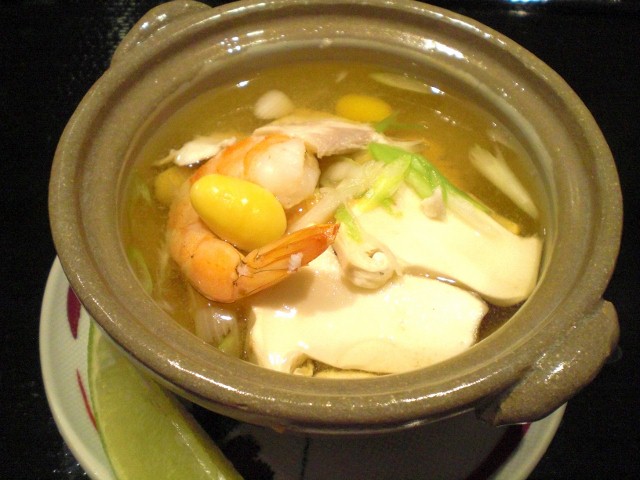
Broth: For this dish, I think you have to make the dashi from scratch. I made a classic ichiban dashi 一番だし with kelp and bonito flakes. I seasoned it with light colored soy sauce, sake, mirin and salt. I did not want a very strong seasoning here. The main ingredient is matsutake--you have to let it speak for itself. When matsutake is cooked with other ingredients in the borth, it becomes much more complex albeit still very subtle.
Other items: Many cooks use chicken meat for this dish but I do not. Chicken is too strong even breast meat. Instead I used thinly sliced pieces of fluke (a type of flounder or other white meat fish without a strong flavor), boiled ginko nuts or "ginnan" 銀杏 (from a can in my case), small shrimp (frozen) and thinly sliced scallion. In a gently simmering seasoned broth, I placed the fish first, shrimp, ginnan and matsutake and gently cooked (or warmed through) for a few minutes. I then put sliced scallion (More traditional condiment will be "mitsuba" 三つ葉 but I did not have it.) If available, a Japanese citrus called "kabosu" カボス, which is very similar to "yuzu" 柚子 is traditionally used. Since I do not have easy access to those, I served it with a wedge of lime. Just before eating, I squeezed the lime juice over the dish. The way to enjoy this dish is to sip the broth and then have some mushroom etc. (Did I say etc? I was told nobody uses "et cetra" any longer. My wife told me etc. means "entire thought collapse"). This was a reasonable approximation of the classic dish. You definitely need cold sake for this delicate dish.
Monday, September 27, 2010
Matsutake steam baked in sake 松茸の酒蒸し焼き
Certain mushrooms are highly prized among gourmands. For the French, it is truffles. For the Japanese, it is matsutake 松 茸 . Japanese domestic matsutake is very scarce since it only grows in pine forests which are apparently disappearing from the Japanese countryside. I learned that Chinese and Korean matsutakes are more common in the Japanese market nowadays. Here in North America, we can get North American or Mexican matsutake. The latter is more expensive since the shape is more similar to the Japanese domestic variety. The flavor, mostly smell, is very subtle but distinctive. Last week, when we were at Tako Grill, we had this season's first matsutake, grilled or "yaki matsutake" 焼き松茸, which prompted me to look into ordering our own supply of matsutake.
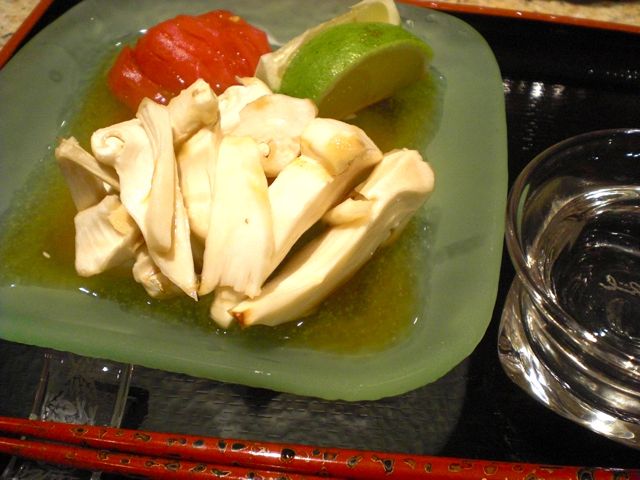
 Since this was a weekday night and we did not have the time or energy to grill matsutake on a charcoal fire, I decided to steam-bake it in an aluminum foil pouch. I first cut into the stem end of the cleaned matsutake and then tore off pieces by hand. I repeated this process until I got reasonably sized pieces (lower left in the above image). I then placed these in a square pouch I made from aluminum foil. I sprinkled sake over the mushrooms and let it be absorbed by the matsutake for a few minutes. I added light-colored or usukuchi shouyu 薄口醤油 (1 tsp) and closed the pouch with enough air space so the steam could rise as it cooks. I placed the pouch in a 500F toaster oven for 5-7 minutes. I did not want to overcook the mushrooms. When the pouch was opened (lower right in the image above), a heavenly earthy aroma of matsutake filled the air. The smell immediately evoked the image of colored leaves and the cool weather of fall. I served the matsutake with the juice accumulated in the bottom of the pouch as a sauce. I added a bit more salt and some lime juice. This has such a subtle and delicate flavor but we have to have it at least once a year because it wouldn't be autumn if we didn't smell it and taste it. You need cold sake with this.
Since this was a weekday night and we did not have the time or energy to grill matsutake on a charcoal fire, I decided to steam-bake it in an aluminum foil pouch. I first cut into the stem end of the cleaned matsutake and then tore off pieces by hand. I repeated this process until I got reasonably sized pieces (lower left in the above image). I then placed these in a square pouch I made from aluminum foil. I sprinkled sake over the mushrooms and let it be absorbed by the matsutake for a few minutes. I added light-colored or usukuchi shouyu 薄口醤油 (1 tsp) and closed the pouch with enough air space so the steam could rise as it cooks. I placed the pouch in a 500F toaster oven for 5-7 minutes. I did not want to overcook the mushrooms. When the pouch was opened (lower right in the image above), a heavenly earthy aroma of matsutake filled the air. The smell immediately evoked the image of colored leaves and the cool weather of fall. I served the matsutake with the juice accumulated in the bottom of the pouch as a sauce. I added a bit more salt and some lime juice. This has such a subtle and delicate flavor but we have to have it at least once a year because it wouldn't be autumn if we didn't smell it and taste it. You need cold sake with this.
We used get matsutake (either North American or Mexican) from a Japanese mail order house but they charge an arm and leg. So this year, I did a web search, found a company in Oregon called "Oregon mushroom, LLC" and decided to give their product a try. This (left upper in the image below) is 1 lb of matsutake, which was sent to us overnight by FedEx and arrived in good condition. It is not too expensive (relatively speaking) at $28/lb but it took almost the same amount of money for the overnight delivery. The matsutake was quite fragrant--more so than what we received previous years from other places. The lovely, characteristically earthy smell wafted out the minute we opened the box. The Matsutake was also quite dirty when it arrived as you can see. Washing it in water is not recommended. I used a moist paper towel and gently rubbed the surface to remove as much of the dirt as I could. I then used a sharp paring knife and sliced off the very bottom, then removed the surface of the bottom end as if I were sharpening a pencil (lots of sands attached). I also removed any embedded dirt and sand (I would rather sacrifice a bit of the mushroom than bite into dirt and sand--something we experienced at some restaurants in the past.) The upper right in the image below is after this cleaning process.
Sunday, September 26, 2010
Fajitas ファヒタス
When we had the landscaping done for our new house in California many years ago, all the workers, except for the boss, were from Mexico. They asked if they could use our Weber grill which was kept outside to cook some meals. We said it was OK with us as long as they cleaned up afterward. We assumed they were using it occasionally to cook burgers for their lunch. One weekday evening when we came home from work, they were still there working. They asked if we would like to try "carne asada" with them. We felt a bit funny about this (being invited to dinner at our own house using our own grill). Nonetheless we were curious and accepted the invitation. They quickly and expertly made a fire in the Weber. They produced a skirt steak from the enormous cooler they had with them, seasoned it simply with salt then grilled it over the hot coals. They also warmed up tortillas and served the carne asada, thinly sliced, with a store bought but very tasty and spicy salsa on it. Obviously, they knew the best salsa and tortillas to buy. We all ended up companionably standing around the grill on the concrete slab patio amid the chaos of the on-going landscaping eating our fill. We learned something from that meal. It was very simple yet sophisticated--much more than the burgers we had imagined they were eating. It was also nutritiously well-balanced (meat, starch and vegetables). The best part was how it smelled as it cooked. I still remember how it made my mouth water.
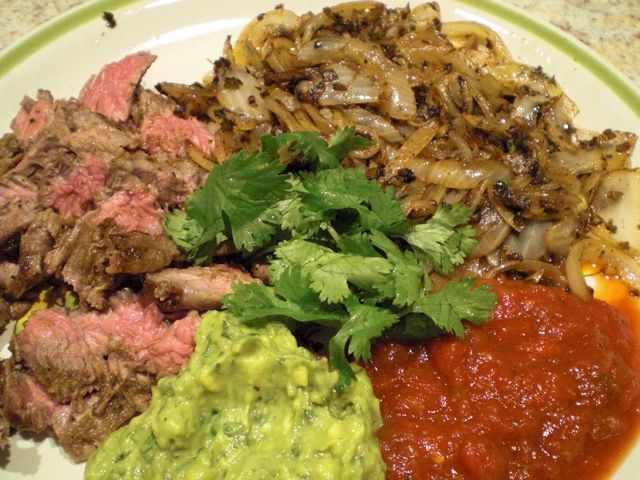
A Tex-Mex version of similar dish is called "fajitas" which is extremely popular in the U.S.. Since I had a package of skirt steak in our refrigerator, I made my version of "fajitas" on Sunday. I was too lazy to fire up the grill outside and made "fajitas" in a skillet (which is the usual way to cook fajitas anyway).
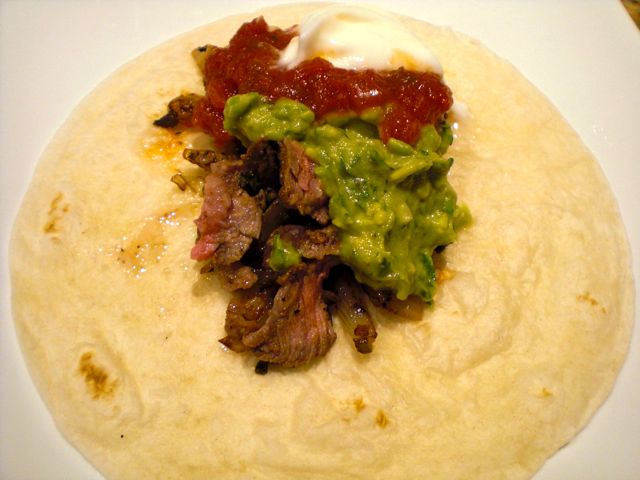
To eat, we warmed small flour tortilla, placed onion, steak, guacamole, salsa on the tortilla and top the whole thing with plain yogurt (or sour cream). We like yogurt, which cuts the heat (spice).
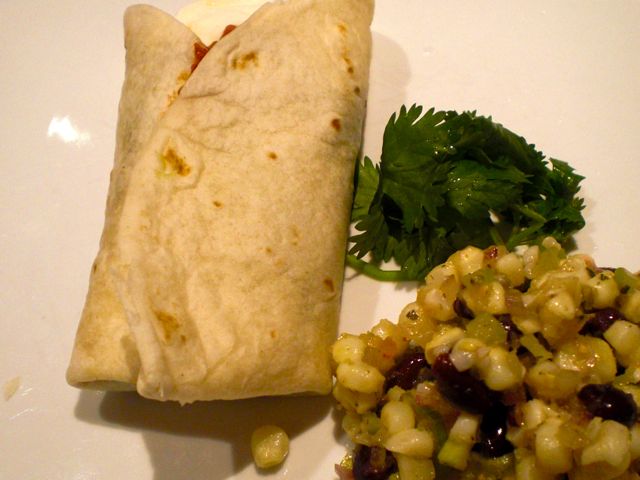
I first rubbed ground cumin, salt and black pepper on the surface of the skirt steak and let it sit for 10-15 minutes. The marinade is lime juice (2 tbs or one lime), olive oil (2 tbs), ground cumin (1 tbs, but use your judgement, we like cumin a lot but it is strong spice), jalapeno pepper (two, seeded and deveined and finely chopped), garlic (3 fat cloves, finely chopped), and fresh cilantro (2-3 tbs, finely chopped including the stem). I also sliced one large onion (halved and then thinly sliced). I placed everything in a Ziploc bag including the meat and let it marinate for several hours or overnight in the refrigerator.
To cook, I took out the steak and if the surface is too wet, I blot it with a paper towel and season it with salt and pepper again (lightly). I use a "grill" pan which has ridges on the bottom to make char marks, and cook the steak for 1 minute on each side for medium (or to your desired doneness) on high flame with a small amount of olive oil. I set the steak aside on a plate and loosely cover it with an aluminum foil. I then cook the onion with all the marinade for 5 minutes on high flame stirring often or until the onion becomes soft and partially browned. I served the steak sliced across the grain, onion, guacamole (homemade), and salsa (store bought, this was not the best. I did not have good tomatoes to make salsa myself).
Roll it up and serve it with black bean corn salad, which was made by my wife a few days ago. We have not had this for a long time and it tasted very good--reminiscent of the one we had in so long ago in California.
Friday, September 24, 2010
Pork filet mignon cutlet 豚のヒレカツ
Over 10 years ago, on one of our visits to Japan, we stayed in Kyoto (as usual) for several days. During this stay, we were taken to a "tonkatsu" トンカツrestaurant (I do not recall the name). As soon as we opened the door, the smell of deep fried pork wafted out and made us salivate. I am sure eating deep fried pork is historically a rather new introduction to Japan but it is a very popular Japanese Western-style dish. Many restaurants specialize in it and each has their secret sauce and/or special pork. Among "tonkatsu", the kind made of tenderloin or fillet mignon of pork called "hirekatsu" ヒレカツ is considered the ultimate. It is unfortunately not particularly dietetic and I have not made this for some time.

Since the weather has been very nice, even chilly in the morning and the evening, I suggested cooking "hirekatsu" outside so that we didn't have to worry about splattering the stove and the lingering smell of deep fry permeating the house. Meanwhile, we could enjoy staying outside. Our set up is shown below. This electric wok is powerful enough to heat the oil over 170C (340F) for proper deep frying.
Breading: I used the usual process of dredging the medallions in AP flour, putting them through a beaten egg/water wash and coating them in Japanese panko. It is best to let it sit in the refrigerator for several hours before frying since the breading will stick better.
Deep frying: As you can see in the picture above, I placed the breaded medallions of pork in the oil when the temperature is about 150C (300F) since the medallions were rather thick, I started with a relatively low temperature. It takes 7-8 minutes turning once. After 4-5 minutes, I cranked up the heat so that the oil temperature reached 170C (340F). When the bubbles around the meat become small, I take out the thickest piece and test to make sure it is done (picture below).
Pennsylvania Dutch style sweet and sour coleslaw: My wife mentioned that the only raw cabbage she ate as a child (and she really liked it) was Pennsylvania Dutch style coleslaw (shown in the little bowel in the lower left of the picture). Since I had never tasted it she decided to make if for me. I helped by chopping up the carrot and cabbage into a fine dice. The dressing calls for vinegar, sugar, egg, salt, butter and cream. It is somewhat similar to Béarnaise sauce but much sweeter. This is how my wife made it; rice vinegar (1/4 cup), sugar (1/2 cup), egg (one beaten, we used pasteurized egg) and butter (1/2 tbs) and cream (1/4 cup). Mix everything (except the cream) in a double boiler. Stirring constantly with a whisk until the sauce becomes thick. Quickly chill the mixture while stirring by putting the pan in an ice water bath. Once the mixture is completely cooled stir in the cream. Add the sauce to the carrot/cabbage mixture and let it sit at least a few hours.
For additional condiments, I also served sweet vinegar, pickled carrot, daikon and cucumber and beer marinated daikon. I also made miso soup with maneko mushroom なめこ, tofu and finely sliced scallion.
The "hirekatsu" was so good with crunchy breading and tender meat. I served it with "Bulldog" brand semi-thick tonkatsu sauce" and a Japanese mustard. You can make your own tonkatus sauce by mixing ketchup and Worcestershire sauce. My wife liked her sweet coleslaw which reminded her of her childhood but it was way too sweet for me. (With all that sugar, is it a surprise kids like it?) I realized I do not like raw cabbage as much as I thought I did. We counteracted the ill effect of the fried food by liberally administering a good Spanish red, Portal del Montsant Santbru 2007 .
Wednesday, September 22, 2010
Japanese sweet vinegar pickles 野菜の甘酢漬け
This is a starter plate we had one evening; crab cake, spinach with creamy black sesame sauce (left and right in the back of the image below) and daikon, cucumber and carrot pickled in sweet vinegar (front).
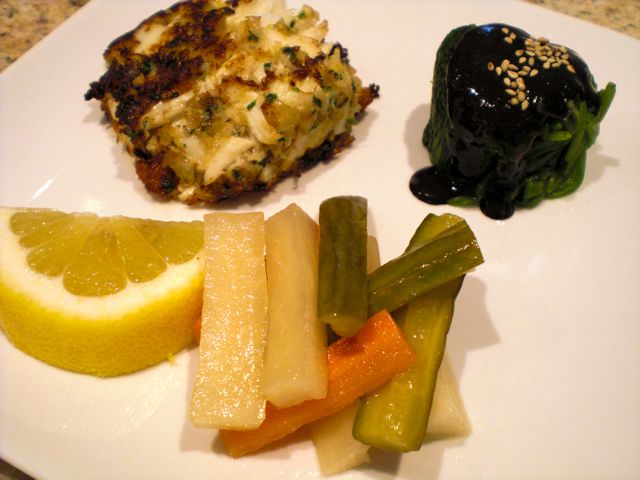
This is a sort of eclectic combination but it happens often with us depending on what is available. Since we had leftover crab meat after making the California roll, I made that into small crab cakes. I got a bunch of fresh spinach (not a baby kind in a bag), so I made spinach with black sesame sauce. I found a bottle of good vinegar tucked in the back of the pantry and used it to make sweet vinegar. I used the sweet vinegar to make a Japanese style chicken escabeche, which followed this plate. The pickled vegetable dish picture here is another dish I made with the sweet vinegar.
Pickling liquid: In the sweet vinegar (1/2 cup), I added yuzu shoyu sauce (1 tbs, from the bottle) and just a dash of dark roasted sesame oil.
Vegetables: I cut daikon, cucumber and carrot into small batons (about 2 inch long and 1/4 inch wide) as seen above. I blanched the carrot for 1 minute and drained. In a frying pan on high flame, I added olive oil (1 tbs) a dash of sesame oil and red pepper flakes. I briefly (30-40 seconds) sauteed all the vegetables and put them in the pickling liquid while it was hot. After cooling down to the room temperature, I covered the container and placed it in the refrigerator. You need to leave the veggies in the pickling liquid at least 24 hours or up to several days.
The pickles in the picture are about 2 days old. The color of the cucumbers is a bit off but all the vegetables were still nicely crunchy with a gentle sweet vinegar taste. Compared to asazuke, these are true Japanese pickles and are a very refreshing condiment.
Subscribe to:
Comments (Atom)

